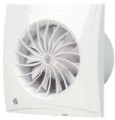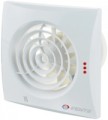Type of bearing
The type of bearing installed in the fan.
The bearing is a part that secures the rotating part of the fan to the stationary part and reduces friction between these parts. By type, it can be as follows:
— Plain bearing. The action of such bearings is based on the friction between two conjugated, that is, directly pressed one to the other over the entire area, surfaces. However, these surfaces are in contact with each other relatively weakly — between them is a layer of lubricant that reduces friction. In addition, to reduce resistance, rubbing parts are usually carefully polished and made of anti-friction materials. The main advantage of plain bearings is the simplicity of design and the resulting low cost. However, such parts are less durable than ball bearings, and they create more noise.
— Ball bearing. The principle of operation of a ball bearing is that a set of balls is placed between its movable and stationary parts, which roll inside during movement. Compared to plain bearings, such bearings last much longer, and they create less noise during operation. On the other hand, fans with similar equipment are noticeably more expensive.
Country of origin
The country specified as the manufacturer of the fan. Note that in most cases, this paragraph indicates the country of origin of the brand under which the unit was released. This country may not coincide with the place of production of individual components, or even with the final assembly place, and often such information is just a marketing ploy that plays on national stereotypes — for example, many consider German technology to be more reliable than Chinese. At the same time, these stereotypes are gradually losing relevance — in particular, due to the transfer of production mentioned above; and it makes sense when choosing to focus on reviews of real customers and the reputation of a particular brand, rather than on its national identity.
Now the following producing countries are represented on the market:
Germany,
Spain,
Italy,
China,
Latvia,
Lithuania,
Norway,
Poland,
Sweden.

